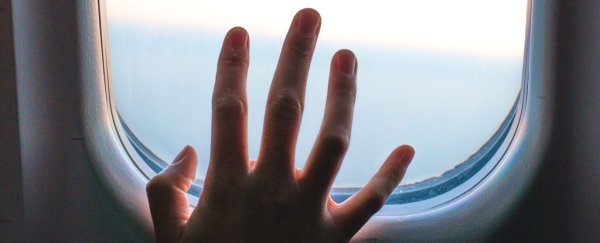The airplane had only just reached cruising altitude when flight attendants asked passengers if there was a doctor on board.
Luckily, there was, and probably much to the relief of the flight crew, given they believed one of the passengers on-board was having a stroke – a dangerous, sudden blockage of blood to the brain, which can lead to brain damage and sometimes death.
But as doctor and medical professor Alan J. Hunter from Oregon Health & Science University found out when he volunteered to assess the patient, the man's strange and severe symptoms were something quite different.
"When I met the passenger, I found him to be young and fit looking, with a complete right-sided facial droop," Hunter writes in a newly published case report on the recent incident.
"In addition to the facial droop, he had lost his forehead wrinkles and could not close his right eye."
The passenger explained that several minutes earlier, during the plane's ascent, he'd experienced a sudden headache on the right side of his head, accompanied by ear pain and a sensation of pressure.
Despite slurred speech and drooling, the young man was fully mentally alert and could talk, displaying normal physical strength and coordination. He explained to Hunter that he had no medical conditions, but had recovered from a head cold the day before.
If it had been a stroke the man was having, the airplane would have had to land as soon as possible, so the passenger could receive urgent medical attention.
But the passenger's symptoms – consistent with a form of facial paralysis called Bell's palsy, the causes of which are often unclear – did not necessitate turning the plane around, Hunter concluded.
Whatever had triggered this rapid-onset facial paralysis, it wasn't a stroke, Hunter thought, but something else: something most likely linked to the flight, and specifically, taking off, which was when the symptoms began.
"I focused on the timing of the event, which occurred during ascent, and the patient's resolving upper respiratory infection," Hunter explains.
"I wondered whether declining atmospheric pressure in the cabin might have led to a relative increase in middle ear pressure from a blocked eustachian tube that was transmitted to the branches of the seventh nerve as they ran through his middle ear."
The passenger was administered oxygen-enriched air, and asked to try to relieve pressure in his ears, using methods like yawning, swallowing, and the Valsalva manoeuvre. After 15 minutes of this, he reported feeling better and his ear blockage was gone; a few minutes after that, all of his symptoms seemed to have resolved.
After landing, Hunter researched the strange symptoms the man experienced, and found there were precursors in the medical literature, including a documented case of 'plane palsy' described in a report from 2018.
"I identified several cases described as facial barotrauma," Hunter says.
Most frequently, however, the problems arise in circumstances involving scuba diving.
"The condition occurs during ascent in scuba divers and infrequently while flying, during land travel at high altitudes, after certain operations on the middle ear, and with some structural disorders of the middle ear," he adds.
According to Hunter, facial barotrauma like this can occur when atmospheric pressure decreases – as happens in a plane cabin during take-off. When this happens, pressure in the middle ear increases, leading to what's called ischemic dysfunction of the facial nerve (aka neurapraxia).
While the symptoms are severe and may be distressing – not only because they resemble some of the tell-tale signs of an acute stroke – the good news is that unilateral facial paralysis like this is only temporary, and can be fixed with 15-30 minutes of exercises to relieve middle ear pressure, and by breathing oxygen-enriched air.
"Most cases are self-limited but rarely may be persistent or recurrent," Hunter writes.
"Prophylactic antihistamines, decongestants, or corticosteroids may reduce mucosal edema and secretions and prevent recurrent episodes."
The findings are reported in Annals of Internal Medicine.
